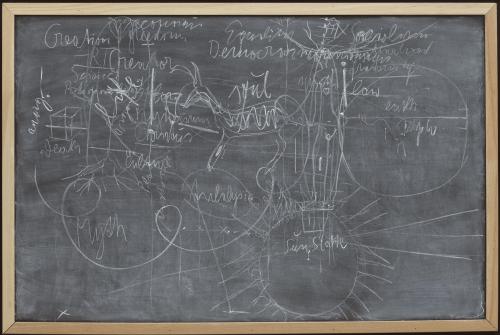Teaching Artist - Blog Posts
I wrote about Asawa's journey to become a renowned artist and art educator in a post titled "Weaving Art with Life." Read it now on Artfully Learning: https://theartsandeducation.wordpress.com/2022/11/15/weaving-art-with-life/
![Ruth Asawa Teaching Paper Folding, Ca. 1980s [© Estate Of Ruth Asawa]](https://64.media.tumblr.com/c6697e63db07e75713b9443a406a9541/2bbbef9b26c5b1e4-6d/s500x750/168a1e1b79e95e732420c4cb6bd78cd67fab00ba.png)
Ruth Asawa teaching paper folding, ca. 1980s [© Estate of Ruth Asawa]

Sister Corita Kent’s "10 Rules for Students, Teachers, and Life," 1967-68.
Corita Kent’s list for students, educators, and everyday experiences, serves as sagely and flexible advice for living life in a more creative capacity. It incorporates the trials and tribulations, as well as the joys of being an artist (or being artful) and/or an educator. Read more about the pedagogy behind Kent's list in my Artfully Learning post "Making a list, checking it twice, going to receive some artistic advice"

Susan Leopold, Classroom, 2022, mixed media construction, digital print mounted on Plexiglas, electrical lighting, LED light bulb and wood, 18 x 12 x 10 inches. Courtesy of the artist and Elizabeth Harris Gallery.
Susan Leopold's series "School(s)" expresses the cultural and pedagogical zeitgeist of the past several years. You can read about her intimate sculptures of school interiors and their connection to the many facets of the educational environment in the Artfully Learning post "School(s)" ; and also listen to a conversation between Susan and I on the Artfully Learning Audio Series Episode 1: School(s).
I wrote about the empowering educational theories within Ej Hill's artwork on my blog, Artfully Learning. Read the post: https://theartsandeducation.wordpress.com/2021/06/09/artfully-assessing-an-american-education/

“#Lesson #3” by EJ Hill @iheartbeuys Photo by @juliafeatherphoto More info at: https://barbarapicci.com/2022/06/03/lesson-3-by-ej-hill/
#tenderness #artinstallation #installazione #installation #installationview #exhibitionview #cultureisfreedom #artisfreedom #curiositykilledtheblogger #artblogging #photooftheday #artaddict #artistsoninstagram #amazing #artwork #instacool #instaart #followart #artlover #contemporaryart #artecontemporanea #artmuseum #artcurator #artwatchers #artcollectors #artdealer #arthistory
https://www.instagram.com/p/CeYAooho2mO/?igshid=NGJjMDIxMWI=
The lineage of many popular educational materials used in schools today can be traced through art history. In a post called "The Art of Child's Play," I wrote about several examples of modern and contemporary artists creating educational toys and learning materials. Read it on Artfully Learning: https://theartsandeducation.wordpress.com/2022/03/24/the-art-of-childs-play/


Puppets by Paul Klee named the Philistine, Matchbox Spirit, and the Crowned Poet — Source: Zentrum Paul Klee, Bern (CC BY-SA 4.0).Puppets by Paul Klee named the Old Man, the Devil with Ringed Glove, and the Monk — Source: Zentrum Paul Klee, Bern (CC BY-SA 4.0).1)
2) Puppets by Paul Klee named the Ghost of a Scarecrow, Electrical Spook, and Mr Death — Source: Zentrum Paul Klee, Bern (CC BY-SA 4.0).

3) Puppets by Paul Klee named the Philistine, Matchbox Spirit, and the Crowned Poet — Source: Zentrum Paul Klee, Bern (CC BY-SA 4.0).
“And yet for all their fixedness, the figures’ power lies in their yet being infinitely accessible, innocent, and welcoming things; they are children who have survived their childhood, grown old, but retained something of that early state. They are representatives of some world that belongs at once to children and adults, and to some more mysterious world they share within creation. Klee wrote in his diary of 1901: “The future slumbers in human beings and needs only to be awakened. It cannot be created. That is why even a child knows about the erotic.”2″

Puppets by Paul Klee named the Big-Eared Clown, Self-Portrait (of Klee), and the White-Haired Eskimo — Source: Zentrum Paul Klee, Bern (CC BY-SA 4.0).
via

One of Paul Klee’s teaching notes on pictorial creation, reproduced from ‘Paul Klee: Life and Work,’ the authoritative Klee overview, back in print from @hatjecantzverlag The many books on Paul Klee (1879-1940) published over the years should not obscure the fact that there has been no new, comprehensive Klee overview since Will Grohmann’s oft-reprinted 1954 monograph. With 'Paul Klee: Life and Work,’ the @zentrumpaulklee has set out to fill this gap, drawing on a wealth of new resources including the Klee family’s archives, much of which is published here for the first time. Life and work are truly integrated in this massive, 344-page volume: Klee’s vast body of work is surveyed chronologically, as the book narrates his life alongside the abundant reproductions of drawings, paintings, watercolors, sculptures, puppets and numerous archival documents and photographs (nearly 500 reproductions in total). The book divides Klee’s career into eight periods: “Childhood and Youth”; “Munich and the Encounter with the Avant Garde”; “World War I and the Breakthrough to Success”; “At the Bauhaus in Weimar”; “Master of Modern Art”; “The Move to Dusseldorf and the Nazi Rise to Power”; “First Years of Emigration in Bern”; and “Final Years.” The result of many years of research and labor, this magisterial publication demonstrates conclusively why Klee numbers among the most influential and best-loved artists of the past 100 years. Read more via linkinbio. #paulklee #klee #bauhhaus #pictorialcreation #pedagogy #teachingnotes #abstraction https://www.instagram.com/p/CNVmXWQppb_/?igshid=1a3e8wtaf3oag

Josef Albers examining a folded paper construction with his students at Black Mountain College, 1946. Photograph by Genevieve Naylor.
5 years and over 200 Artfully Learning blog posts later, I finally got around to writing about Black Mountain College. "Weaving Art with Life" describes the unique art-centered pedagogy of the school that shaped the course of modern art history. Read it now on Artfully Learning: https://theartsandeducation.wordpress.com/2022/11/15/weaving-art-with-life/

Winold Reiss, Elise J. McDougald, 1925. Public domain, via Wikimedia Commons.
German painter Winold Reiss' paintings and drawings of Harlem residents included both renowned civil rights leaders and unsung social reformers like local teachers. Instead of rendering them from the lens of an outsider, he was committed to portraying and advocating their achievements and cultural prowess. One example is the portrait he made of Harlem educational reformer, Elise J. McDougald who became the first African-American woman principal in New York City public schools during the late nineteenth century.
Read more about Reiss' multicultural portraits and his unique approach to teaching art in my blog post "Winold Reiss’ Intersectional Art Education" https://theartsandeducation.wordpress.com/2022/08/26/winold-reiss-intersectional-art-education/
![Ruth Asawa Teaching Paper Folding, Ca. 1980s [© Estate Of Ruth Asawa]](https://64.media.tumblr.com/c6697e63db07e75713b9443a406a9541/2bbbef9b26c5b1e4-6d/s500x750/168a1e1b79e95e732420c4cb6bd78cd67fab00ba.png)
Ruth Asawa teaching paper folding, ca. 1980s [© Estate of Ruth Asawa]

